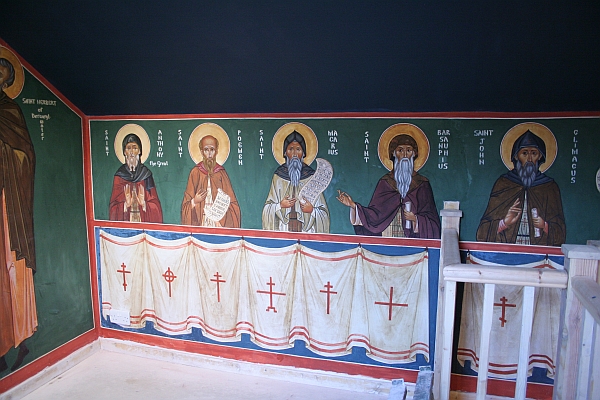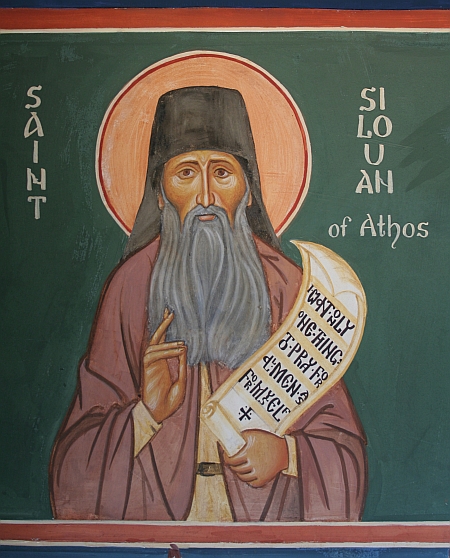Aidan Hart's Icons in Fresco
 When I was in my early thirties (quite late to be making these decisions) I made an earnest decision to try to learn icon painting. I telephoned the only icon painter I knew, someone whom I had met once about five years earlier. Since I had met him, Br Aidan had spent a number of years on Mt Athos and on returning to England had founded a hermitage, that of SS Anthony and Cuthbert in Shropshire, England. I asked him to teach me icon painting. It was interesting that in response he was interested in my reasons for wishing to paint, rather than my natural ability. He asked me first why I was interested in icons. I had converted to Catholicism just a couple of years earlier and I explained that I wanted to learn to paint to serve the Church. Then (and I can’t remember precisely how he phrased the next question) he asked me what, if anything was possible, I would like to do with my art. I told him that I wanted to be able to paint something like the Sistine Chapel that really gave glory to God on a grand scale.
When I was in my early thirties (quite late to be making these decisions) I made an earnest decision to try to learn icon painting. I telephoned the only icon painter I knew, someone whom I had met once about five years earlier. Since I had met him, Br Aidan had spent a number of years on Mt Athos and on returning to England had founded a hermitage, that of SS Anthony and Cuthbert in Shropshire, England. I asked him to teach me icon painting. It was interesting that in response he was interested in my reasons for wishing to paint, rather than my natural ability. He asked me first why I was interested in icons. I had converted to Catholicism just a couple of years earlier and I explained that I wanted to learn to paint to serve the Church. Then (and I can’t remember precisely how he phrased the next question) he asked me what, if anything was possible, I would like to do with my art. I told him that I wanted to be able to paint something like the Sistine Chapel that really gave glory to God on a grand scale.
 He didn’t laugh (which is what I was half expecting). I remember him saying, ‘This sounds good.’ Then he paused and said: ‘I’m frescoing the chapel at the hermitage at the moment. Would you like to come and stay with me and help me?’ This was extraordinarily generous of him. So off I went to stay with him for a week and this was my introduction to frescoing. I was shown how to mix the plaster, how to apply it, and then how to paint onto the partially hardened plaster. He had built a wooden container about 2ft square and 2” deep to contain an area of plaster. As an exercise, I painted on this a copy of a Minoan fresco from Crete.
After this introduction to the medium, I assisted him with the chapel itself, mostly lifting and grunt work. The most valuable lesion was watching Aidan doing the painting. Aidan was much better at painting than me, but also, as a result of being a hard-working hermit and farmer, he was also in much better shape than me. My recollection is that I was not particularly helpful and did most of the grunting, while he did most of the lifting. Nevertheless, by the end of the week he did allow me to assist in some minor detailing on the chapel wall and painted some faux drapery.
He had a tiny chapel, perhaps 15ft square, which he frescoed from floor to ceiling. The iconostasis separated a sanctuary about 4ft wide from the body of the chapel. Once it was finished, to see a church painted from floor to ceiling took the breath away.
He didn’t laugh (which is what I was half expecting). I remember him saying, ‘This sounds good.’ Then he paused and said: ‘I’m frescoing the chapel at the hermitage at the moment. Would you like to come and stay with me and help me?’ This was extraordinarily generous of him. So off I went to stay with him for a week and this was my introduction to frescoing. I was shown how to mix the plaster, how to apply it, and then how to paint onto the partially hardened plaster. He had built a wooden container about 2ft square and 2” deep to contain an area of plaster. As an exercise, I painted on this a copy of a Minoan fresco from Crete.
After this introduction to the medium, I assisted him with the chapel itself, mostly lifting and grunt work. The most valuable lesion was watching Aidan doing the painting. Aidan was much better at painting than me, but also, as a result of being a hard-working hermit and farmer, he was also in much better shape than me. My recollection is that I was not particularly helpful and did most of the grunting, while he did most of the lifting. Nevertheless, by the end of the week he did allow me to assist in some minor detailing on the chapel wall and painted some faux drapery.
He had a tiny chapel, perhaps 15ft square, which he frescoed from floor to ceiling. The iconostasis separated a sanctuary about 4ft wide from the body of the chapel. Once it was finished, to see a church painted from floor to ceiling took the breath away.
 Fresco is a medium that is not seen very often today. A summary of the method can be seen on Aidan’s website here, along with more of his work. There are some considerations that ought to be considered. First, the pigment is painted onto wet plaster which can be worked on for about a day after application. This means that there is always visible join between one day’s work and the next. The easiest way to stop this being too much of a distraction is to consider how much you can do in a day and allow the plaster line to coincide with a line in the final composition. It also means that in order to cover large areas (even those areas in this chapel would be very large paintings if put onto panel or canvas) the artist needs to be able to work expertly and fast. Aidan is both expert and fast, but even it is noticeable that he rations the time-consuming modeled areas to those that really need it, the faces. In the areas of drapery, for example, he relies far more on flat colour and line to describe form than he would in for example, his panel icons. This is fine for icon painting, which relies on line strongly to describe form. In more naturalistic styles, the ability to summarise form into simple shapes of tone with minimal blending is necessary to cover at speed those areas that are not the primary focus of interest. This is immensely difficult. This is why one can never cease marvel at the skill of, for example, Michelangelo or Raphael in their work in the Vatican.
Also, deep shadow is difficult to portray in fresco. In this respect it is rather like egg tempera. Dark colours are possible, as we can see in Aidan's work, but they tend to look flat, rather like soot sitting on the surface, rather than creating an illusion of deep space in the way that a transparent glaze of dark oil paint does.
This is not a problem for the iconographic form which deliberately seeks to destroy the illusion of space. It also makes it very good for decorative or patterned work which relies on flat areas of colour and tone that contrast with each other. In those forms that rely on deep shadow, the problem is more difficult. The naturalistic painters particularly those working in the styles of the High Renaissance and the baroque had to adapt by learning to work in a higher register of colour as effectively a half of the spectrum of tone is denied to them. This involves great skill. I wrote a couple of weeks ago about the work of Tiepolo, which has a distinctive light, airy feel. The high register colours he uses in his oil paintings look to me like oil versions of those that you see in fresco. Tiepolo was an expert in both media. I cannot prove this, but it has occurred to me that perhaps the restrictions placed by fresco open up the route to the developments he made in his oils.
All the frescoes shown are by Aidan Hart at www.aidanharticons.com
Fresco is a medium that is not seen very often today. A summary of the method can be seen on Aidan’s website here, along with more of his work. There are some considerations that ought to be considered. First, the pigment is painted onto wet plaster which can be worked on for about a day after application. This means that there is always visible join between one day’s work and the next. The easiest way to stop this being too much of a distraction is to consider how much you can do in a day and allow the plaster line to coincide with a line in the final composition. It also means that in order to cover large areas (even those areas in this chapel would be very large paintings if put onto panel or canvas) the artist needs to be able to work expertly and fast. Aidan is both expert and fast, but even it is noticeable that he rations the time-consuming modeled areas to those that really need it, the faces. In the areas of drapery, for example, he relies far more on flat colour and line to describe form than he would in for example, his panel icons. This is fine for icon painting, which relies on line strongly to describe form. In more naturalistic styles, the ability to summarise form into simple shapes of tone with minimal blending is necessary to cover at speed those areas that are not the primary focus of interest. This is immensely difficult. This is why one can never cease marvel at the skill of, for example, Michelangelo or Raphael in their work in the Vatican.
Also, deep shadow is difficult to portray in fresco. In this respect it is rather like egg tempera. Dark colours are possible, as we can see in Aidan's work, but they tend to look flat, rather like soot sitting on the surface, rather than creating an illusion of deep space in the way that a transparent glaze of dark oil paint does.
This is not a problem for the iconographic form which deliberately seeks to destroy the illusion of space. It also makes it very good for decorative or patterned work which relies on flat areas of colour and tone that contrast with each other. In those forms that rely on deep shadow, the problem is more difficult. The naturalistic painters particularly those working in the styles of the High Renaissance and the baroque had to adapt by learning to work in a higher register of colour as effectively a half of the spectrum of tone is denied to them. This involves great skill. I wrote a couple of weeks ago about the work of Tiepolo, which has a distinctive light, airy feel. The high register colours he uses in his oil paintings look to me like oil versions of those that you see in fresco. Tiepolo was an expert in both media. I cannot prove this, but it has occurred to me that perhaps the restrictions placed by fresco open up the route to the developments he made in his oils.
All the frescoes shown are by Aidan Hart at www.aidanharticons.com





